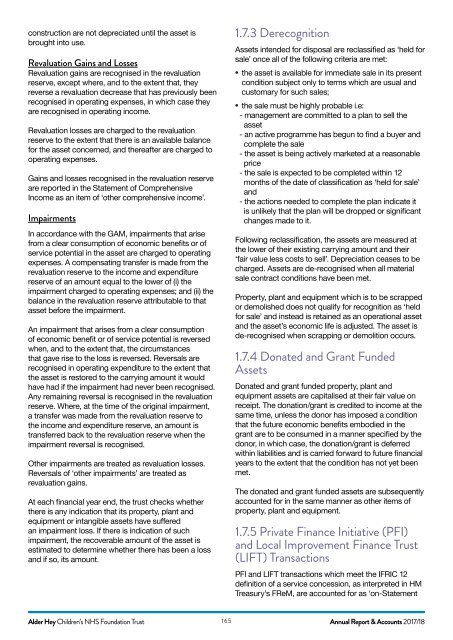AH ANNUAL REPORT 2018
Create successful ePaper yourself
Turn your PDF publications into a flip-book with our unique Google optimized e-Paper software.
construction are not depreciated until the asset is<br />
brought into use.<br />
Revaluation Gains and Losses<br />
Revaluation gains are recognised in the revaluation<br />
reserve, except where, and to the extent that, they<br />
reverse a revaluation decrease that has previously been<br />
recognised in operating expenses, in which case they<br />
are recognised in operating income.<br />
Revaluation losses are charged to the revaluation<br />
reserve to the extent that there is an available balance<br />
for the asset concerned, and thereafter are charged to<br />
operating expenses.<br />
Gains and losses recognised in the revaluation reserve<br />
are reported in the Statement of Comprehensive<br />
Income as an item of ‘other comprehensive income’.<br />
Impairments<br />
In accordance with the GAM, impairments that arise<br />
from a clear consumption of economic benefits or of<br />
service potential in the asset are charged to operating<br />
expenses. A compensating transfer is made from the<br />
revaluation reserve to the income and expenditure<br />
reserve of an amount equal to the lower of (i) the<br />
impairment charged to operating expenses; and (ii) the<br />
balance in the revaluation reserve attributable to that<br />
asset before the impairment.<br />
An impairment that arises from a clear consumption<br />
of economic benefit or of service potential is reversed<br />
when, and to the extent that, the circumstances<br />
that gave rise to the loss is reversed. Reversals are<br />
recognised in operating expenditure to the extent that<br />
the asset is restored to the carrying amount it would<br />
have had if the impairment had never been recognised.<br />
Any remaining reversal is recognised in the revaluation<br />
reserve. Where, at the time of the original impairment,<br />
a transfer was made from the revaluation reserve to<br />
the income and expenditure reserve, an amount is<br />
transferred back to the revaluation reserve when the<br />
impairment reversal is recognised.<br />
Other impairments are treated as revaluation losses.<br />
Reversals of ‘other impairments’ are treated as<br />
revaluation gains.<br />
At each financial year end, the trust checks whether<br />
there is any indication that its property, plant and<br />
equipment or intangible assets have suffered<br />
an impairment loss. If there is indication of such<br />
impairment, the recoverable amount of the asset is<br />
estimated to determine whether there has been a loss<br />
and if so, its amount.<br />
1.7.3 Derecognition<br />
Assets intended for disposal are reclassified as ‘held for<br />
sale’ once all of the following criteria are met:<br />
• the asset is available for immediate sale in its present<br />
condition subject only to terms which are usual and<br />
customary for such sales;<br />
• the sale must be highly probable i.e:<br />
- management are committed to a plan to sell the<br />
asset<br />
- an active programme has begun to find a buyer and<br />
complete the sale<br />
- the asset is being actively marketed at a reasonable<br />
price<br />
- the sale is expected to be completed within 12<br />
months of the date of classification as ‘held for sale’<br />
and<br />
- the actions needed to complete the plan indicate it<br />
is unlikely that the plan will be dropped or significant<br />
changes made to it.<br />
Following reclassification, the assets are measured at<br />
the lower of their existing carrying amount and their<br />
‘fair value less costs to sell’. Depreciation ceases to be<br />
charged. Assets are de-recognised when all material<br />
sale contract conditions have been met.<br />
Property, plant and equipment which is to be scrapped<br />
or demolished does not qualify for recognition as ‘held<br />
for sale’ and instead is retained as an operational asset<br />
and the asset’s economic life is adjusted. The asset is<br />
de-recognised when scrapping or demolition occurs.<br />
1.7.4 Donated and Grant Funded<br />
Assets<br />
Donated and grant funded property, plant and<br />
equipment assets are capitalised at their fair value on<br />
receipt. The donation/grant is credited to income at the<br />
same time, unless the donor has imposed a condition<br />
that the future economic benefits embodied in the<br />
grant are to be consumed in a manner specified by the<br />
donor, in which case, the donation/grant is deferred<br />
within liabilities and is carried forward to future financial<br />
years to the extent that the condition has not yet been<br />
met.<br />
The donated and grant funded assets are subsequently<br />
accounted for in the same manner as other items of<br />
property, plant and equipment.<br />
1.7.5 Private Finance Initiative (PFI)<br />
and Local Improvement Finance Trust<br />
(LIFT) Transactions<br />
PFI and LIFT transactions which meet the IFRIC 12<br />
definition of a service concession, as interpreted in HM<br />
Treasury’s FReM, are accounted for as ‘on-Statement<br />
Alder Hey Children’s NHS Foundation Trust 165<br />
Annual Report & Accounts 2017/18


